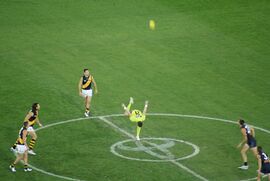Australian rules football
Australian rules football, or footy, is a sport more complex than both soccer, as it involves more body parts and umpires, and rugby, as it involves running in multiple directions. In most instances there are more stretchers involved than in cricket.
History[edit]
Footy was an invention commissioned by the Channel Seven Network so that there would be weekend television other than the Pommy imports of gardening and Antiques Road Show during winter. While several managers of the Network were visiting a gaol in Melbourne, they were amused by a brawl which broke out over a pig's bladder that resulted in a pileup of convicts who did not remember what they were fighting over in the first place. When the prison warden came in with a whistle, it occurred to them that they had just witnessed the perfect sport for television. Upon hastily returning to the studios, they ordered their men to put on some horizontally and vertically striped jumpers and got them to tackle each other in a giant backyard.
After adding an oblong ball amidst the confusion, this new sport proved so popular with the studio audience that they would pile up in a similar manner due to the sheer number of spectators. Footy finally became a proper game when the events were moved to dormant cricket stadiums and goalposts inserted in 8 random positions. To allow for advertising during the game, various 'stoppages' were implemented, including the centre bounce, an excuse for play to restart at the middle of the field after every goal. For similar commercial reasons, matches are strategically divided into four quarters rather than two halves.
The Game[edit]
Field[edit]
Footy can be played on any ovular, rectangular or asymmetrical field in the world, as long as it there is enough space for a Toyota logo and for tossing a coin, and perhaps two on ANZAC day. On opposite ends of the field, four thin trees are planted so that the ruckmen of both teams can fit through sideways. These are burnt down during Grand Final celebrations to make way for cricket in summer, and replanted at the beginning of the pre-season next year.
Ball[edit]
Official Australian Rules footballs are produced by the "all Australian" company Sherrin, which guarantees that at least . Prior to 1978, all footballs were made out of kangaroo leather; the switch to the cheaper cow hide came when the RSPCA launched its "Equality of Animals and Man" campaign, which deemed that kangaroos have a special place in Australian society on the 50 cent coin and deserve not to be skinned. This is akin to how dogs are our companions, and should not be eaten, while chickens may be consumed provided they are raised cage free.
General rules[edit]
The rules of football are best characterised by what is not permitted, among which are throwing the ball, pushing a player in the back and chopping a player's head off. Efforts to adhere to these rules usually result in a general melee, followed by either a ball-up or a free kick against the player "in possession" of the ball, which in some cases means their shin is on top of the ball yet underneath another player's belly.
The scoring system of goals being worth 6 points and behinds 1 point was introduced by the Federal government as an incentive for young Australians to properly learn their multiplication tables, especially for those who aspire to become commentators or goal umpires.
50 metre Penalty[edit]
The 50 metre penalty involves the umpire blowing his whistle and telling everybody to move play 50 metre in the direction of the umpire's choice, which he indicates by pointing in the opposite direction. In the 2004 Grand Final between Port Adelaide and the Brisbane Lions, umpire James T. Kirk gave the 50 metre penalty upwards. He died in a later riot when the game was drawn nil all at the final siren.
Umpiring[edit]
In footy, there are three field umpires to police the game on the field, none of whom have the right to give players detention. In general a field umpire does nothing until play gets too congested, at which point he either
- chooses his favourite player and gives them a free kick;
- decides that he deserves the ball more than anyone else and calls 'mine'; or
- is unsure of who deserves the ball, raising his hands in the air and calling 'play on'.
Boundary umpires are known for their good relationship with the spectators. As part of their sponsorship deal, they make the assumption that players and spectators have poor eyesight, and boundary throw-ins are done so that all people, from the ground up to the third level of the stadium, can get a good glimpse of the ball.

